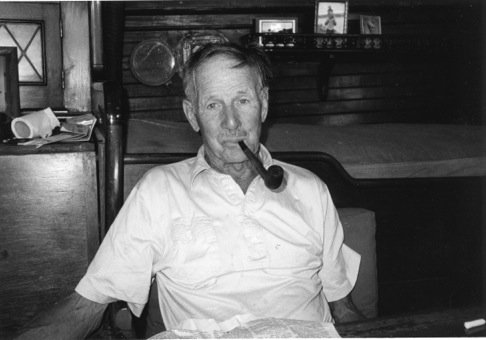By Annie Sutter and Larry Clinton, Sausalito Historical Society
In 1985 the Historical Society’s Annie Sutter wrote a lengthy profile in this paper on fisherman, sailor, sailing instructor, charter skipper and local legend Cass Gidley. Here’s a lightly edited and updated excerpt that describes Sausalito’s days as a fishing village:
PHOTO FROM SAUSALITO HISTORICAL SOCIETY
Cass Gidley in a rare moment ashore.
Cass has been around Sausalito since the days when fishermen kept Montereys [double-ended fishing boats] in the cove off Hurricane Gulch, since those long-ago days when, he reports, “I sold crab for $l,” and he remembers that the fishing fleet was divided into factions of Italians and non-Italians, and seldom did the two meet without trouble. But he first arrived at that cove by sailboat. “The first time I ever set foot in Sausalito was in 1929. I was attracted by the building of Zaca at the Nunes yard. I lived out at Pt. Pinole and sailed my little 16’ lapstrake clinker over here to watch Zaca being built. That was a big trip, you know, back and forth across the Bay. [Charles Templeton] Crocker gave me deck work on Zaca, but no big voyages. I should’ve gone when they sailed in 1930. [Zaca was later acquired by swashbuckling actor Errol Flynn.]
Oh, I had another chance to sail round-the-world on the Otter, a great big reconverted fish packer from Alaska, but I got married instead. In those days there were only three boats anchored off Sausalito, the Dragoon, a big racing ketch, the Otter, and another off the point where the Spinnaker is today. Just those and a handful of fishing boats — no docks oh, they had a little fishing dock this side of the Napa St. Pier.”
During WWII he worked in the shipyards as a high rigger. “I put all the staging around the ships,” and at the same time, took up commercial fishing at night. “I started commercial fishing in 1941, got bit by the bug. Me with no experience but I liked the sea. I leased a 40' double ender, the Nina, and fished crab, salmon and albacore. We didn't travel far offshore in those days, but we worked hard for very little money. Salmon brought 12 cents a pound, but money wasn't the real thing, it was the adventure we had out there. I learned navigation fishing; in those days all we had was a compass, no radios. I was the first to have a radio aboard. It was just rule of thumb navigation, picked it up in bits.”
At first, the young fisherman sold his catch at Fisherman's Warf in San Francisco, but soon ran into trouble with the establishment, the Italian fishermen who ran the wharf.
In Neptune's Apprentice, a warm and comprehensive book about the fishing business, author Marie de Santis introduces Cass as “one of those few seekers whose last name didn’t roll off the tongue like a Verdi opera,” and tells how the young fisherman found that his rivals were cutting the buoys off his crab pots and substituting their own. So he followed along behind and re-exchanged the buoys, and brought them back and tossed them on the docks where the fishermen tied up. When his rivals then began taking the entire pots full of crabs, Cass worked all night emptying all the crab pots to return with a full load. “Still, those were some of the best years of my life, and we were all the best of friends.” Cass is quoted as saying. “It’s just the fisherman’s way.
"But finally I got away from it and made my headquarters in Sausalito, in the mid 40s. I sold all my fish through Lefty Sturiales, down at Gate 3. He was a famous character, known up and down the coast. That pier at Gate 3 is still known as Lefty’s Dock. Lefty was fair to the fishermen.” In the early 50’s, in partnership with Ernie Gann (another aspiring fisherman, but one who was to find it more lucrative to write about the industry), Cass set up a shop downtown. [Gann later gained fame as the author of classics such as The High and the Mighty, Fate is the Hunter, and other novels which became major motion pictures.]
The two sold fresh fish directly off their boats to the locals. “The City gave us a float right where the ferry is now, and we sold tons and tons of fish. We’d fish for a week and come in on Thursday and sell on Friday. The people came right down to the dock; we had so many people we had to give out numbers! Of course, the merchants and the butchers tried to get us out, and so the City took the float away from us. And one night all the ladies from the Hill went down to the City Council and demanded that those two boys get that boat back to work down there. And so we went back.”
Cass Gidley passed away in 1998, but his memory is being preserved by The Sausalito Community Boating Center, a non-profit organization established to create a nautical community place at Gidley’s old marina near Dunphy Park.

